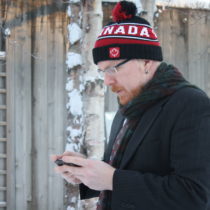Landscape Architecture for Landscape Architects › Forums › PLANTS & HORTICULTURE › Heated Sidewalks and Street Trees
- This topic has 1 reply, 12 voices, and was last updated 13 years, 4 months ago by
Dennis J. Jarrard, PLA, CLARB.
-
AuthorPosts
-
February 23, 2011 at 1:00 pm #164656
 Rob HalpernParticipant
Rob HalpernParticipantA client asked me to review plans for a project already well under construction.
It is in the cold cold North and includes street trees (in tree “pits”) surrounded by snow melt system for the sidewalk. The sidewalk and its snow melt system extend over the tree pit (but no closer than 4′ from the trunk of the tree). There is to be rigid insulation between the CU-structural soil and the heating system/sidewalk.
While this is not what I was asked to review, it struck me as dicey for the long-term health of the trees (Acer saccharum) in the cold cold North. So it’s an opportunity for me to learn something.
Anyone have any experience with trees’ health over time in such conditions?
February 23, 2011 at 2:54 pm #164691Dennis J. Jarrard, PLA, CLARB
ParticipantI am having a hard time visualizing this, can you provide a detail?
February 23, 2011 at 3:44 pm #164690 Rob HalpernParticipant
Rob HalpernParticipantHi Dennis,
Since I am not the originator nor really “on the team” I can’t post their detail.
Imagine a 14′ diameter tree pit with cantilevered sidewalk over it to an 8′ diameter tree grate.
CU-structural soil below sidewalk within tree pit
Insulation material and sidewalk with embedded heating cables above.
I hope that is clarifying
February 23, 2011 at 4:50 pm #164689 Peter BriggsParticipant
Peter BriggsParticipantRob:
How far North? We have various somewhat similar installations in Alaska. One of my concerns was the ability of the tree to go fully dormant. (i.e. with heated sidewalk above, even with insulation, will the soil freeze?) For one project I was involved with, the potential solution was to try to get an air-gap between the soil and slab system that would allow for the soil to freeze. This is kind of counter-intuitive for a properly designed heated sidewalk though… and adds expense because the slab either needs to span to get the air-gap, or more economically probably… use something like Silva Cells, and don’t fill them all the way (that’s the direction we were headed). The heated sidewalk really throws a wrench into things, since there isn’t much information out there on how well it interacts with plantings.
Peter
February 23, 2011 at 4:54 pm #164688 Rob HalpernParticipant
Rob HalpernParticipantPeter,
that is exactly my concern: full dormancy and also the tree experiencing a “false thaw” during any milder winter weather.
Location is Minnesota.
Your air gap makes perfect sense to me
How have your Alaskan trees done?
February 23, 2011 at 4:58 pm #164687Tanya Olson
ParticipantI wonder if you could get in touch with arborists or whoever is in charge of the street trees for the City of Minneapolis? There are heated sidewalks downtown and street trees – Gleditsia mostly if I remember correctly – they were in tree grates as well.
I would bet that the trees had no insulation from the sidewalk heat….they were mature and fairly healthy when I lived and worked in the city over 11 years. The main damage to the trees was from snow removal. My guess is that the sidewalks aren’t really that warm – just above freezing and that the root ball stays frozen if the location has adequate moisture.
February 23, 2011 at 5:01 pm #164686 Peter BriggsParticipant
Peter BriggsParticipantI’m not sure what the final installation section was (I’ll see if I can find out), but they appear to be doing well enough. For us, we have other street tree issues (as with many locations)… so the discussion is more along the lines of “should we really be putting trees here?”. I think emerging consensus will probably be that rather than shoe-horning trees into locations and fighting with the details to optimize their possible survival… we find the opportunities to really allow them to maximize chances. At the same site on another side, with unheated sidewalks, we put the trees in raised planters. With unheated sidewalks, snowmelt substances really do seem to contribute to ill health. So, raised planters get them out of the way of that… as well as out of the way of the snow clearing equipment (typically four wheelers with plows that seem to not only run into trunks, but also break tree grates), and the issues with being recessed even slightly in a planting pit (garbage, silt, everything that gets down there and piles up… encouraging trunk rot). I digress… I’ll see if I can get anything meaningful for you…
February 23, 2011 at 5:09 pm #164685 Rob HalpernParticipant
Rob HalpernParticipantStill, Gleditsias can be so much tougher than sugar maples, and they leaf out late anyway so they may be better suited to this treatment.
Since it is not my project and was not the issue I was asked to evaluate all I felt I could do was draw the client’s attention to my concerns while acknowledging my lack of experience with such a situation. I believe there is a local L.A. who is responsible.
But a call to the city arborist could teach me something!
February 23, 2011 at 5:39 pm #164684Mike G
ParticipantHi Rob,
I have no experience with this type of system…however I too would be concerned with those details. From the plants perspective this type of system may catalyze some of the extreme weather conditions that induce winter injury. I would suspect sunscald and early/late frost damage will do a number on these trees eventually.
Northern trees, especially sugar maples, benefit from having even and gradually frozen soils. That freeze/thaw period could rapidly increase sap flow way to late and early and impart major cellular damage. This could be brought on by the insulation preventing the soils from cold hardening the plant tissues as well as firing up the boilers and soil temperatures early or late in the season.
If the tree is in an exposed area wrapping the trunks may help ease sun scald potential until the bark thickens, but as far as the sap flow issue..? Who knows. Good luck.
February 23, 2011 at 5:48 pm #164683 Thomas J. JohnsonParticipant
Thomas J. JohnsonParticipantThat’s one big tree pit and tree grate. I’d like to see that… I’m only familiar with the standard city-sidewalk tree grates…
Acer saccharum might be a poor choice for that application since it is very sensitive to root compaction and disturbances. It also has a laterally branching root structure that stays close to the surface (probably not a good combination with the heating element for both the tree and heating elements sake). How about a nice Linden, Ginko or Oak instead? Their roots are deeper and they are less fussy in general…
February 23, 2011 at 5:52 pm #164682 Rob HalpernParticipant
Rob HalpernParticipantYeah, I absolutely agree. I was surprised at the choice.
But when I was brought in the trees were “on the way” (!)
I refer to these as street trees, but plaza might better capture the feel of the place
February 23, 2011 at 5:55 pm #164681 Rob HalpernParticipant
Rob HalpernParticipantOf all the concerns, sun scald is actually my least. The trees penetrate a shade structure.
But it seems that all who have posted so far are uncomfortable with the idea especially for this species. Just as I was.
If someone in addition to Peter would chime in with their successful or failed experience I’d have more to take to the client.
February 23, 2011 at 6:07 pm #164680 Jason T. RadiceParticipant
Jason T. RadiceParticipantCombo of the trees, the CU soils, and the insulating foam are troublesome. Sounds like a bad detail all the way. I actually don’t know anywhere where Acer Saccharum are used as street/plaza trees around here, but I’m not that far north. I think the trees are the least of the problem, though, provided you do have the air gap to stop the roots from heaving the sidewalks. The foam actually attracts insects, so I’d dump that immediately. I’d reccommend using a system like DeepRoot or another structural support system with better soils and suitable air gap in place of the CU soils. You’ll get better results as there is no compaction and the structure of the “boxes” create an air gap for the tree and stops the roots. You can also work this into the stormwater system if you want, and don’t have to provide a full “pit”, rather a channel for the roots to go to. Remember, maples are top rooting, so they are the worst for heaving sidewalks.
February 23, 2011 at 6:16 pm #164679 Thomas J. JohnsonParticipant
Thomas J. JohnsonParticipantIf the pits are dug, the grates and trees delivered and the design of the heating system/sidewalk has been determined, what exactly are they asking you to do? It seems that if you’re input can’t change anything, you’re only taking on personal liability by consulting on a project that has inherent flaws. Isn’t the best thing to do at this point to say, “yup, that’s not gonna work. wish you called me earlier.” and walk away…? What’s to be gained by you or the client at this point?
February 23, 2011 at 6:28 pm #164678 Peter BriggsParticipant
Peter BriggsParticipantKnowledge. =)
And perhaps logical (pehaps cost neutral) alterations that might increase chances for success. If they’re spanning/cantilevering the pavement, leaving an air gap might be an option… and even if only for a small radius around the tree.
When we were researching this about 6 years ago, there just wasn’t much information out there on interactions between heated sidewalks and plantings. We found one instance where the planting method was really poor (vertically insulating the walls of a typical sidewalk 4×4 tree pit/coffin. This discussion today is great!
As to liability… my assumption is that any liability to Rob would only happen if he were signing the final drawings or approving the changes. New information isn’t really a bad thing… it just might be too late.
-
AuthorPosts
- You must be logged in to reply to this topic.

